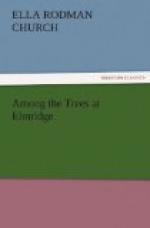[19] Sequoia gigantea.
When the children had sufficiently exclaimed over the size of this huge tree, their governess continued:
“It is thought that these trees must have been growing for more than two thousand years, which would make them probably two hundred years old at the birth of our Saviour. Does it not seem wonderful to think of? There are other groups of giant pines scattered on the mountains and in the forests, and some youthful giants about five hundred years old.”
“I suppose they are the babies of the family,” said Clara; and this idea amused Edith very much.
“There is still another kind of pine,” said Miss Harson—“the Italian, or stone, pine. It is shaped almost exactly like an umbrella with a very long handle. The Pinus pinea bears large cones, the seed of which is not only eatable, but considered a delicious nut. The cone is three years in ripening; it is then about four inches long and three wide, and has a reddish hue. Each scale of which the cone is formed is hollow at the base and contains a seed much larger than that of any other species. When the cone is ripe, it is gathered by the owners of the forest; and when thoroughly dried on the roof or thrown for a few minutes into the fire, it separates into many compartments, from each of which drops a smooth white nut in shape like the seed of the date. The shell is very hard, and within it is the fruit, which is much used in making sweetmeats. The stone-pine is found also in Palestine, and is supposed to be the cypress of the Bible. The author of The Ride Through Palestine[20] speaks of passing through a fine grove of the stone-pine, ‘tall and umbrella-topped,’ with dry sticks rising oddly here and there from the very tops of the trees. These sticks were covered with birdlime, to snare the poor bird which might be tempted to set foot on such treacherous supports; and if the cones were ripe, they would be quite sure to do it. Here is the picture, from the book just mentioned. Italian pine is a prettier name than stone-pine, and this is the name by which it is known to artists, who put it into almost every picture of Italian scenery.
“’Much they
admire that old religious tree
With shaft above the
rest upshooting free,
And shaking, when its
dark locks feel the wind,
Its wealthy fruit with
rough and massive rind.’”
[20] Presbyterian Board of Publication.
[Illustration: STONE-PINE—“FIR” (Pinus maritima)].
“But how queer it sounds to call fruit wealthy!” said Malcolm.
“It is odd,” replied his governess, “only because the word is not now used in that sense; but the fruit is wealthy both because of its abundance and because it can be put to so many uses. Let us see what is said of it:




